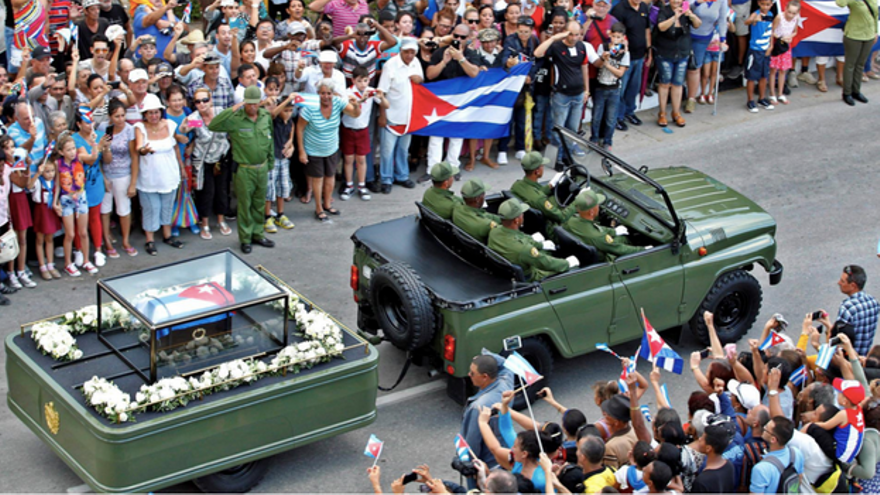
![]() 14ymedio, Yunior Garcia Aguilera, Madrid, August 16, 2022 — Does the Cuban revolution still exist? For some it ended at the exact moment Fidel Castro delared it to be Marxist. In the pages of Bohemia years earlier he had accused Fulgencio Batista of being the communists’ candidate in the 1940 election, of being photographed with Blas Roca and Lazaro Peña. Socialists writing for New York’s Daily Worker criticized the assault on the Moncada Barracks, characterizing it as a fool-hardy adventure, a provocation, a putsch. Even a far-left Chilean journalist claimed the events of July 26 had been organized by the CIA.
14ymedio, Yunior Garcia Aguilera, Madrid, August 16, 2022 — Does the Cuban revolution still exist? For some it ended at the exact moment Fidel Castro delared it to be Marxist. In the pages of Bohemia years earlier he had accused Fulgencio Batista of being the communists’ candidate in the 1940 election, of being photographed with Blas Roca and Lazaro Peña. Socialists writing for New York’s Daily Worker criticized the assault on the Moncada Barracks, characterizing it as a fool-hardy adventure, a provocation, a putsch. Even a far-left Chilean journalist claimed the events of July 26 had been organized by the CIA.
In his biography, History Will Absolve Me, Fidel makes no mention of Marxism. In interviews with journalist Herbert Matthews in the Sierra Maestra, he would deny that Marxist ideas played any role in his movement. And after taking power in 1959, he would again swear before the press and the entire world, in Spanish and in English, that he categorically rejected communism. To associate him with that ideology, he said, was “a smear campaign.”
But Eisenhower’s less-than-polite welcome during Castro’s visit to the United States would motivate Khrushchev to send an emissary. The revolution’s red shift was not borne of conviction, much less of popular demand. It was the result of a bruised ego. It was also the pragmatic solution of a street fighter. If he was going to take on the neighborhood bully, he had to join forces with another bully of the same weight and size as that of his enemy.
In December 1961 Fidel Castro not only betrayed all his democratic promises, he also killed off his “green as the palm trees” experiment, turning it into something else.
Thus began another revolution, one that aroused the sympathy of many leftist intellectuals, who saw in it the chance to cleanse socialism of its Stalinist stain. “It will be different in Cuba,” they claimed. Their enthusiasm would wane in 1968, however, when the bearded lover exposed his hairy chest. The Revolutionary Offensive to nationalize all of Cuba’s remaining small businesses was irrational and extremist. Censorship of poets was rampant. Che died disheveled and alone in a Bolivia that he neither knew nor cared about. Fidel supported Soviet tanks’ rolling into Prague. That year marked the end of another revolution: the romantic one.
A new constitution in 1976, a carbon copy of the bureaucratic Eastern European model, consolidated the state. Cuba had officially become a satellite, with the constitutional text itself serving as the marriage contract. The rhetoric and liturgy of the Leninist creed reached their climax in a country that, just a few years earlier, did not know how to say tovarisch (comrade) or spasiva (thank you).
Seemingly solidified, the regime managed to survive the 1980 Mariel crisis but would again be in mortal decline by the end of the decade. Perestroika and glasnost had supporters among the population but the nation’s leaders were not about to give up even a millimeter of their absolute control. The firing-squad execution of General Ochoa, a Hero of the Republic, along with three other officials sent a loud and clear warning. Not long after, General Abrahantes, a former interior minister and head of Fidel’s security detail, died in prison. As far as the Cuban public and the world at-large were concerned, it all had something to do with drugs. For reformist factions within the palace, it was an ultimatum.
So began the fifth life of a cat named Revolution. Like a feline on a hot tin roof, tired and bleary, it had to survive. People took to the streets for the first time to challenge the regime. They later took to the seas on anything that would float. After the economy hit bottom, strategists revived Bastista’s dream of filling the country with hotels. There was no miracle capable of multiplying the loaves and the fishes. Only the problems and the prostitutes multiplied.
A new feline life-cycle began when Castro took off his uniform and put on a suit to receive the pope. With Chavez, Evo, Correa and Kirchner in power, it was a new period of optimism: the Pink Tide. The cat thought it would live forever.
But death brought an end to that period too. Four years after Fidel turned to dust, his name lives on in that of a new dynasty. Except that New Man turned out to be just as clumsy as the Golem in Jorge Luis Borges’ poem. And today, lying in literal darkness, the cat counts out its days.
____________
COLLABORATE WITH OUR WORK: The 14ymedio team is committed to practicing serious journalism that reflects Cuba’s reality in all its depth. Thank you for joining us on this long journey. We invite you to continue supporting us by becoming a member of 14ymedio now. Together we can continue transforming journalism in Cuba.
